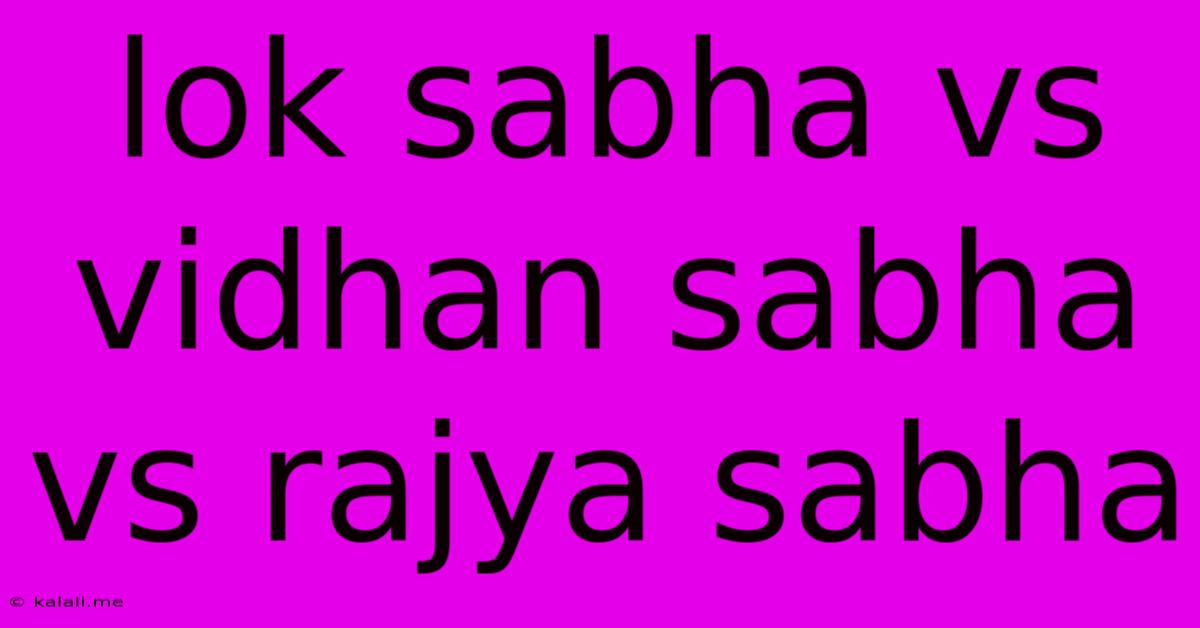Lok Sabha Vs Vidhan Sabha Vs Rajya Sabha
Kalali
Jun 13, 2025 · 4 min read

Table of Contents
Lok Sabha vs. Vidhan Sabha vs. Rajya Sabha: Understanding India's Parliamentary System
India's parliamentary system, a vibrant democracy, operates on a three-tiered structure: the Lok Sabha, the Vidhan Sabha, and the Rajya Sabha. While all three are crucial legislative bodies, they differ significantly in their composition, powers, and functions. Understanding these differences is key to grasping the intricacies of Indian governance. This article will delve into the key distinctions between the Lok Sabha, Vidhan Sabha, and Rajya Sabha, clarifying their roles and responsibilities.
What is the Lok Sabha?
The Lok Sabha, often referred to as the House of the People, is the lower house of the Parliament of India. It's a directly elected body, meaning its members (Members of Parliament or MPs) are chosen directly by the Indian electorate through general elections. The Lok Sabha holds significant power, primarily responsible for the formation and sustenance of the government. Its key characteristics include:
- Directly Elected: Members are chosen by the people through universal adult suffrage.
- Lower House: Holds more power than the Rajya Sabha in financial matters and in the formation of government.
- Government Formation: The party or coalition with a majority in the Lok Sabha forms the government.
- Money Bills: Has exclusive power over money bills – bills related to taxation and government spending.
- No-Confidence Motion: The Lok Sabha can pass a no-confidence motion against the government, leading to its resignation.
- Legislative Powers: Shares legislative power with the Rajya Sabha, but has greater influence.
What is the Vidhan Sabha?
The Vidhan Sabha, or Legislative Assembly, is the lower house of the state legislature in each Indian state. Similar to the Lok Sabha, its members (MLAs or Members of the Legislative Assembly) are directly elected by the people of that state. The Vidhan Sabha is responsible for making laws specific to the state. Key features include:
- State-Level Legislature: Focuses on legislation pertinent to the specific state's needs and concerns.
- Directly Elected MLAs: Elected by the residents of the state.
- State Government Formation: The party or coalition with a majority in the Vidhan Sabha forms the state government.
- State-Specific Legislation: Deals with issues like education, healthcare, agriculture, and local governance within the state.
- Limited Powers Compared to Lok Sabha: Its legislative powers are confined to the state, while the Lok Sabha deals with national-level legislation.
What is the Rajya Sabha?
The Rajya Sabha, also known as the Council of States, is the upper house of the Parliament of India. Unlike the Lok Sabha, it's not entirely directly elected. Members (MPs) are elected indirectly by state legislatures, with representation proportional to the state's population. While it shares legislative powers with the Lok Sabha, its powers are somewhat limited. Its crucial role lies in representing the states' interests at the national level. Key aspects include:
- Indirectly Elected: Members are elected by the members of the state legislative assemblies.
- Upper House: Holds less power compared to the Lok Sabha, particularly concerning financial matters.
- State Representation: Represents the states and ensures their voices are heard in national policy-making.
- Legislative Review: Can scrutinize and amend bills passed by the Lok Sabha, but the Lok Sabha's decision usually prevails.
- No-Confidence Motion: Cannot pass a no-confidence motion against the government.
- Legislative Powers: Shares legislative power with the Lok Sabha, though its powers are somewhat limited.
Key Differences Summarized:
| Feature | Lok Sabha | Vidhan Sabha | Rajya Sabha |
|---|---|---|---|
| Level | National | State | National |
| Election | Direct | Direct | Indirect |
| Primary Role | Lawmaking, Government Formation | State-Specific Lawmaking | Representing States, Legislative Review |
| Power | Greater than Rajya Sabha | Limited to State Affairs | Lesser than Lok Sabha |
| Money Bills | Exclusive Power | No Power | Limited Power (Can Delay, Not Reject) |
Understanding the distinct roles of the Lok Sabha, Vidhan Sabha, and Rajya Sabha is crucial for comprehending the complexities of India's federal structure and its democratic processes. Each body plays a vital role in shaping national and state policies, reflecting the diverse needs and voices within the nation.
Latest Posts
Latest Posts
-
Which Of The Following Is True Of Customer Value
Jun 14, 2025
-
A Time Series Plot Is Also Known As A
Jun 14, 2025
-
How Fast Can A Peacock Run
Jun 14, 2025
-
What Is The Thickness Of The Crust Of The Earth
Jun 14, 2025
-
What Is The Highest Active Volcano In South America
Jun 14, 2025
Related Post
Thank you for visiting our website which covers about Lok Sabha Vs Vidhan Sabha Vs Rajya Sabha . We hope the information provided has been useful to you. Feel free to contact us if you have any questions or need further assistance. See you next time and don't miss to bookmark.